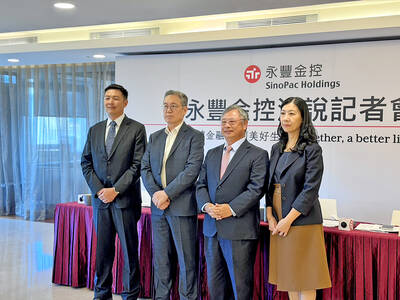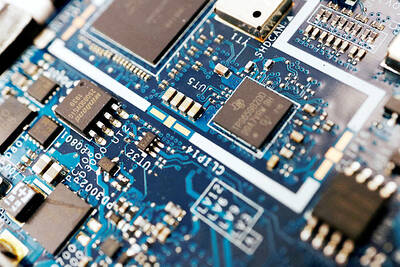For more than 30 years, Intel Corp has dominated chipmaking, producing the most important component in the bulk of the world’s computers. That run is now under threat from a company many Americans have never heard of.
Taiwan Semiconductor Manufacturing Co (TSMC, 台積電) was created in 1987 to churn out chips for companies that lacked the money to build their own facilities. The approach was famously dismissed at the time by Advanced Micro Devices Inc (AMD) founder Jerry Sanders.
“Real men have fabs,” Sanders said at a conference, using industry lingo for factories.
These days, ridicule has given way to envy as TSMC plants have risen to challenge Intel at the pinnacle of the US$400 billion industry.
AMD has chosen TSMC to make its most advanced processors, having spun off its own struggling factories years before.
TSMC’s threat to Intel reflects a sea change in chipmaking that has seen one company after another hire TSMC to manufacture the chips they design.
Hsinchu-based TSMC has scores of clients, including tech giants Apple Inc and Qualcomm Inc, second-tier players like AMD and minnows such as Ampere Computing LLC.
The explosion of components built this way has given TSMC the technical know-how needed to churn out the smallest, most efficient and powerful chips in the highest volumes.
“It’s a once-in-a-50-year situation,” said Renee James, the former No. 2 at Intel who heads start-up Ampere.
Her company is less than two years old and yet it is going after Intel’s dominant server chip business. That Ampere thinks it can compete is a testament to stumbles by Intel and TSMC’s ability to benefit from those mistakes.
It has been a decade since Intel faced major competition and its 90 percent revenue share in computer processing is again to deliver record results this year.
However, some on Wall Street are concerned, and rivals are emboldened, because TSMC has a real chance to replace Intel as the best chipmaker in the business.
Last year, the Taiwanese company amassed a bigger market value than its US rival for the first time.
What Intel investors really worry about is that the largest Internet companies will start making their own chips.
Earlier this week, Amazon.com Inc, the biggest cloud-computing company, announced its first in-house server processor.
The Graviton is made by TSMC and it supports a new version of Amazon’s service that is more than 40 percent cheaper than a similar offering powered by Intel chips, the company said.
Without TSMC’s capabilities, Amazon would not have the option to go it alone, Amazon Web Services Inc vice president Matt Garman said.
“More competition in this space is great,” he said.
Production bragging rights in semiconductors are judged by the width of the space between lines on the tiny circuits that give chips their function. Shrinking that gap — measured in nanometers, or billionths of a meter — gives designers the ability to make chips that count faster, use less power, store more data or simply cost less.
In the highest-end processors, where Intel makes most of its money, space is at a premium. A Xeon server processor crams billions of transistors into an area the size of a postage stamp.
Intel was the first to use 14-nanometer technology at scale in 2013, Goldman Sachs Group Inc said.
It will not have a 10-nanometer process ready for prime time until the end of next year — by far the longest wait in its history.
TSMC has gone from producing 20-nanometer to 7-nanometer chips in the same time.
Intel’s holdup revolves around yield, the number of good chips that emerge from each production run. In plants that cost about US$7 billion and run 24 hours per day churning out millions of chips each month, the slightest hiccup can be disastrous financially.
Intel has not ironed out enough of these manufacturing wrinkles yet and the company will not shift to 10-nanometer production until it is sure everything works properly.
Sanders’ current successor at AMD, CEO Lisa Su (蘇姿豐), does not have to worry about this, because the company sold its factories and lets TSMC handle the complex production.
“That’s one of the best decisions we’ve made,” Su said. “It allows us to manage risk and focus on the things that make the product great.”
With TSMC’s help, Su is pursuing a goal that Sanders never attained: A credible and lasting challenge to Intel’s hold on computing.
AMD is now telling investors and customers that its new chip designs will surpass those from Intel. TSMC makes this competition possible, even though AMD has about one-10th of Intel’s workforce and research and development budget.
However, TSMC did not catch Intel all by itself. The company’s real break came a decade ago, when the smartphone began filling consumers’ pockets.
Intel dabbled in mobile chips, but the US company never committed its best production and design to the area, preferring to prioritize its existing cash cows of PC and server chip businesses.
When smartphone sales took off, handset makers used other processors from companies like Qualcomm, or they designed their own using ARM Holdings PLC technology, like Apple. TSMC factories churned these components out.
The smartphone business is now almost six times as big as the PC industry by volume. That has given TSMC the advantage of high-volume manufacturing experience that previously belonged to Intel.
With billions of transistors on chips, a problem with a small number of those tiny switches can render the whole component useless. Production runs can take up to six months and involve hundreds of steps requiring maniacal attention to detail.
Each time there is a mistake, the factory operator has a chance to make tweaks and try a new approach. If the change works, that information is retained to try on the next challenge.
The more production runs, the better, and TSMC has the most nowadays.
“TSMC just continues to deliver latest chips on schedule without any mistakes,” Sanford C. Bernstein analyst Mark Li said.
He said that he thinks Intel’s leadership in PC and server chips, plus its pricing power, are at risk because of its smartphone slip and TSMC’s hard-earned consistency.
Still, this is far from the first challenge Intel has faced. The company is working on its production problems and in the meantime is to deliver new chips built with existing production technology that it has said would keep the opposition at bay.
Navin Shenoy, head of Intel’s server processor division, has said that nanometer-based production measures have never been the only factor of success (although the company liked to talk about this more in the past).
Intel’s near-term solution is to design better chips using old production technology.
“I’m confident that we’re going to deliver what our customers care about, which is system performance,” Shenoy said.
Historically, Intel has squashed rivals using a research budget that dwarfed anything else in the industry. However, TSMC’s approach is undermining even this advantage.
While Intel still outguns TSMC in capital spending on new plants and equipment, the tables are turned when you combine the research budgets of TSMC clients like Qualcomm, Apple, Nvidia Corp and Huawei Technologies Co (華為).
The combined budgets of TSMC’s customers are not only larger than Intel’s, but the gap is increasing, Goldman Sachs said, adding that by 2020, they would spend almost US$20 billion, at least US$4 billion more than Intel.
“They’re a self-fulfilling prophesy now,” Nvidia executive vice president of operations Debora Shoquist said. “They are the best and the best go to the best.”

On Tuesday, US President Donald Trump weighed in on a pressing national issue: The rebranding of a restaurant chain. Last week, Cracker Barrel, a Tennessee company whose nationwide locations lean heavily on a cozy, old-timey aesthetic — “rocking chairs on the porch, a warm fire in the hearth, peg games on the table” — announced it was updating its logo. Uncle Herschel, the man who once appeared next to the letters with a barrel, was gone. It sparked ire on the right, with Donald Trump Jr leading a charge against the rebranding: “WTF is wrong with Cracker Barrel?!” Later, Trump Sr weighed

SinoPac Financial Holdings Co (永豐金控) is weighing whether to add a life insurance business to its portfolio, but would tread cautiously after completing three acquisitions in quick succession, president Stanley Chu (朱士廷) said yesterday. “We are carefully considering whether life insurance should play a role in SinoPac’s business map,” Chu told reporters ahead of an earnings conference. “Our priority is to ensure the success of the deals we have already made, even though we are tracking some possible targets.” Local media have reported that Mercuries Life Insurance Co (三商美邦人壽), which is seeking buyers amid financial strains, has invited three financial

Artificial intelligence (AI) chip designer Cambricon Technologies Corp (寒武紀科技) plunged almost 9 percent after warning investors about a doubling in its share price over just a month, a record gain that helped fuel a US$1 trillion Chinese market rally. Cambricon triggered the selloff with a Thursday filing in which it dispelled talk about nonexistent products in the pipeline, reminded investors it labors under US sanctions, and stressed the difficulties of ascending the technology ladder. The Shanghai-listed company’s stock dived by the most since April in early yesterday trading, while the market stood largely unchanged. The litany of warnings underscores growing scrutiny of

OUTLOOK: Among the six sub-indices, only the stock market confidence sub-index rose due to strong equity performance and expectations of a US Federal Reserve rate cut Consumer confidence weakened further this month, sliding to its lowest level in two-and-a-half years as households grew increasingly uneasy about the economic outlook, job security and big-ticket spending, a survey by the National Central University showed yesterday. The consumer confidence index fell 1.07 points from last month to 63.31, the weakest number since May 2023, said the university’s Research Center for Taiwan Economic Development (RCTED), which conducts the monthly poll. “Although the Directorate-General of Budget, Accounting and Statistics recently increased Taiwan’s GDP growth forecast for this year to 4.45 percent, consumer sentiment tells a different story,” RCTED director Dachrahn Wu